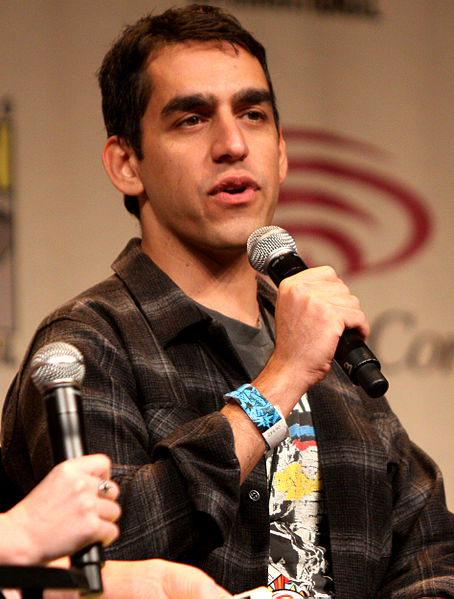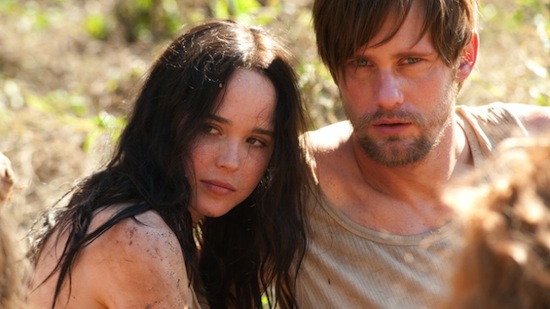“How far would you go to avenge your sister’s death at the hands of a corporation?” This is one of many questions posed by the coming of age, espionage thriller, The East, from director Zal Batmanglij and his co-writer, co-producer, and leading lady, Brit Marling.
Curious to experience firsthand the “freegan movement,” Batmanglij and Marling felt compelled to spend a summer living off the grid — hopping trains, crashing in abandoned buildings and eating “three vegan meals a day by dumpster diving.” These experiences fortuitously provided background for their screenplay, The East, which recounts the story of a young operative at work for a private intelligence firm, who is assigned to infiltrate an anarchist collective suspected of waging attacks on corporations.
Batmanglij and Marling broke onto the film scene in a big way with the debut of their first feature The Sound of My Voice, at Sundance, 2011. Their film garnered critical acclaim, multiple nominations across the festival circuit, and a win for Batmanglij at Palm Springs International Film Festival in the category of “Directors to Watch.” Their second feature, The East was notably produced by Ridley Scott, with Marling headlining an all-star cast (that includes Alexander Skarsgård, Ellen Page, Patricia Clarkson, and Julia Ormond) — which is a rather revolutionary feat of infiltration, in and of itself. How did they do it?
Sophia Stein recently sat down in conversation with Batmanglij at the San Francisco International Film Festival to learn more about the rising director, his methods, and his madness.
Sophia Stein: Your film was shot in 27 days, for $6.5 million, but it looks like a $30 million film. What’s your secret?
Zal Batmanglij: I’ll tell you what my secret is — the best, free, natural resource we have available to us, which is: young people who are hungry to work. … And aren’t just — doing it for the money. By “young people,” what I’m trying to describe are people who are just breaking into a profession for a living. Young people means anybody who wants to be a master at their craft – who has completed their 10,000 hours, as Malcolm Gladwell would say, but who is not quite in the canon yet. So we were those people. I started making movies when I was thirteen. By twenty, I had made twenty short films, but it wasn’t until thirty that I made my first feature – with people who were ready to translate their 10,000 hours into a first product. I had an amazing production designer, Alex Digerlando, and an amazing D.P., Roman Vasyanov. We loved each other so much that someone from the studio dubbed us “The Brothers East.” Initially, the studio was reluctant about Alex, my production designer, because he had only had one credit, and that movie had not yet come out. At first, the studio said no, but I realized that the ball was in my court. I told Alex, we have to make a presentation that will just “wow” everybody. I don’t think Alex slept for two days — he and I sent images back and forth — and he made a knock-your-socks-off presentation. Everyone saw it, and they were like, “Wow, let’s do this,” and we made our movie. Later, after we had finished shooting The East, Alex’s first feature (the one that hadn’t come out yet) played at Sundance, and the studio ended up buying it … a little film you might have heard of, called Beasts of the Southern Wild. So Alex Digerlando is going to be one of the great production designers of our generation. I guess, a lot of people feel when they are making their first feature that they need to work with really experienced people to offset their own lack of experience, but I find that that isn’t necessarily the truth. Especially today, when the technology is changing all the time, and the way the business is done is changing all the time. I believe that you can get a lot more for a lot less money – if you work, for example, with a D.P. who has grown up with digital, like I’ve grown up with digital, which is very different than a D.P. who has been shooting on film since they were eighteen.
S2: What was it like to work with Producer Ridley Scott on The East?
ZB: Talk about 10,000 hours – talk about 100,000 hours, talk about a 1 million hours. You have access to that. Of course, Ridley’s very busy, and you have to use his time wisely, but he was always there — when we were talking about formats or how to shoot this movie. Ridley was great!
S2: Tony Scott (Top Gun, Man on Fire) is also credited on your film —
ZB: Wow, this was one of the last movies that Tony ever saw.
S2: You and Brit Marling (co-screenwriter, co-producer, and star of the film) began your partnership when you were students together at Georgetown?
ZB: We met at the first ever Georgetown University film festival — when Brit was seventeen and I was twenty. The first two short films that I co-directed with my best friend Mike Cahill (Mike went on to make Another Earth in 2011), had just won the festival. We got a standing ovation, and the most enthusiastic leader of the standing ovation was a young, ethereal – but you could even tell then that she had this fierce intelligence – Brit Marling. A week later, Brit tapped me on the shoulder at the grocery story, “Are you Zal? I’m Brit Marling, and I’d like to work with you guys.” She explained that she was taking a photography class and offered to do lights. I asked if she had ever acted in movies. “In high school,” she revealed, and I invited her to be in my next project. We have been preparing for this experience ever since we first met.
S2: You did extensive research to write the screenplay for The East?
ZB: Mike and Brit and I moved out to Los Angeles to become directors, and for Brit to become an actor, and for a long time, no one was giving us permission to do those things. We were hitting a wall. We decided to spend the summer on the road, as a way to make sense of our lives; it had nothing to do with making a movie. We never set out deliberately to do research for a screenplay. That experience on the road was so rattling that when we came back, we decided to make a film set in that world.
S2: Your protagonist is transformed by her experiences with the anarchist collective. In what were the experiences of being on the road transformative for you?
ZB: I felt very alienated and frustrated about being alive in the years 2008-2009. Seeing all these people beat back the alienation through loving each other and working together was transformative. I know that sounds hippy-dippy, but we experienced it, and when you experience that, you realize that other people are really hungry to experience that also. (What else is there really? I don’t know.) The sense of the abundance of that natural resource; I learned that from being on the road. At first, I think the extended family has been under attack in our times. Then the nuclear family has been under attack. Now even partnerships are under attack. Gay marriage is such an interesting issue because it is the meeting point between the government and interpersonal relationships. The fact that relationships can even be decided by the government is one of those crazy things that shows us just how much our interpersonal relationships are under attack.
S2: The East is a counter-culture movie. You have said that “dissatisfaction with contemporary consumer culture” provided the impetus for its creation. Nonetheless, you created the film in the Hollywood studio system, and it has a Hollywood polish. How do you reconcile that discordance?
ZB: We had the choice of making this movie on the road ourselves, and that was a very appealing possibility for us. Or we had the choice of making something that was broader, more polished, and therefore could infiltrate more hearts and minds. We wanted to make a thrilling, entertaining film. We wanted it to feel like first class entertainment, so that it would play in all sorts of places that wouldn’t normally seek out a film like this. On the airplane, in the hotel room — those places where people feel the most alienated in some ways. I think this film asks a lot of questions. It’s in those times – in the hotel room late at night or on the plane, when you are completely physically alienated from the earth, that sometimes it is nice to consider those questions. I often joke (but half seriously) that this is the kind of movie that you should see with someone that you are sleeping with, because it is the kind of story that when you wake up in the morning, you can talk about.
S2: At what point in the process did you attach Ellen Page, Alexander Skarsgård, and Patricia Clarkson?
ZB: We wanted to experience adventure with all the collaborators on the film — with the actors, just as much the production designer and DP. We put forth an open call for adventure. Ellen Page was someone who had lived on a permaculture farm. She was down to party and ready for adventures. Skarsgård is a man with an interesting history. He is from Europe, has lived in America, and is incredibly serious about his work — and takes other people really seriously. Whenever people mob him for photos, he is so gracious with each and every one. That may not seem like a quality that would make him down for “the anarchist spirit of this film,” but actually it is. The spirit of adventure is about kindness and a lack of self-pretention — which he brings to the project. There are a lot of people who feel overwhelmed by their own fame. And there are other people who understand that life is really about giving back — whatever you can do, however much you can give — whether you are a bread maker, or a garbage taker, or an actor who has moved people so they feel the desire to come up and take a photo with you. Skarsgård gives back—even on set; on his day off, he would cook dinner for everybody! Patricia Clarkson had read the script, but didn’t want to commit until she had talked to me on the phone. So we had this hour and a half conversation where she kept asking, “How did you guys write this?!” She joined us in the last week of shooting; she flew down, checked into her hotel, and asked me and Brit to pick her up so that we could have a drink before we started shooting the next day. When we arrived at her hotel, Patricia jumped in the car and exclaimed, “But you guys are twelve!” Patricia is a one-of-a-kind personality; we had so much fun with her on set. I want to see The Patient Stone [here at the San Francisco International Film Festival], with a great actress that I’m excited about, Golshifteh Farahani, who did Body of Lies with Ridley Scott.
S2: The Sound of My Voice and The East both provide an entry point into the world of cults. How would you describe your overarching intention as a filmmaker?
ZB: I want to try to make sense of this world that we live in by making films. I want to be part of people moving towards a solution, rather than being part of the problem.
Where can you see ‘The East’? Find out here.
Images: Top: director Zal Batmanglij, photo by Gage Skidmore, Wikimedia Commons; below, a scene from ‘The East.’


